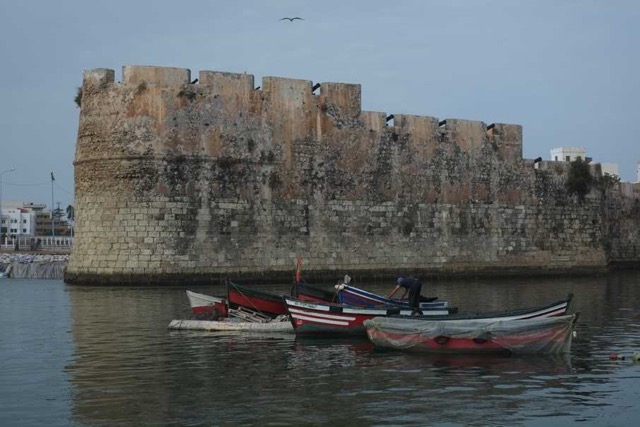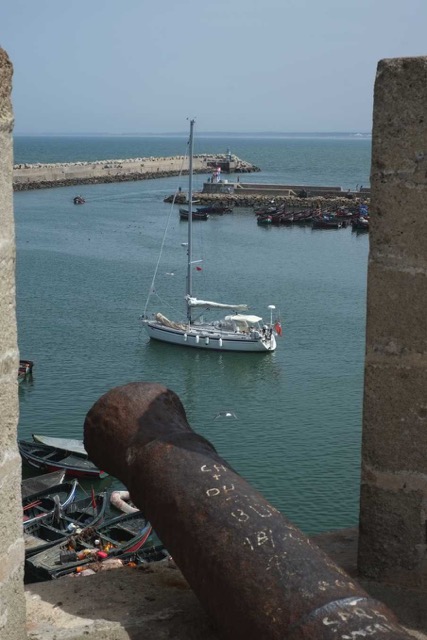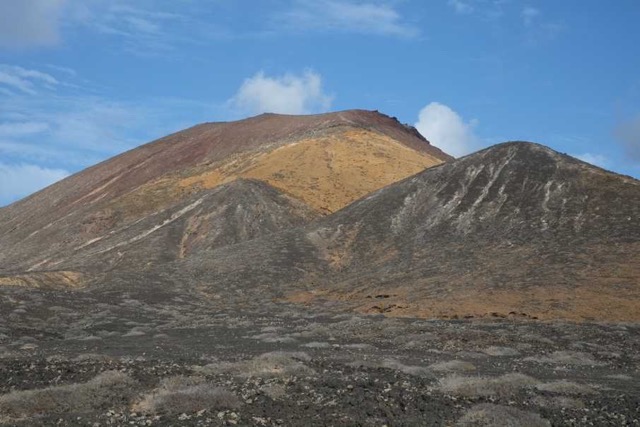Sailing Matters

Vega
Hugh and Annie
Wed 30 Sep 2015 22:00
| The prevailing trade winds along the Moroccan coast at this time of year are apparently from the north. Unless affected by a low pressure system in the Atlantic in which case the wind can blow from the south or south west. This appears to have been the case with us as there was what appeared to be a really big and deep depression that came up and across north west Spain and into Biscay. Notwithstanding the Passage Weather forecasts of northerly wind we had light or moderate wind from the south for most of our journey south. This meant yet more engine hours when the wind was light or close hauled tacking when it was stronger. We resorted to the staysail if the wind was more than 15kts or a lot of tacking was required. You need to furl our genoa when tacking in order to get it around the inner forestay. With the wind from the south and the Atlantic swell coming in from the west you get the the steep waves and rolling motion we experienced off the Spanish coast. The Hydrovane steers by the wind and the auto helm by the compass. In neither case do they take account of the waves and so you tend to bash into them or fall off the top with a bang. This kills your speed and can make life rather frustrating. The answer, we found, is to steer by hand just like in the dingy sailing days many years ago. You can feel the reaction of the boat to the waves through the wheel and instead of bashing into them head on you steer up one side and down the other at an angle. Combined with the force of the wind on the sails and the luffing of the boat in the gusts you can feel at what angle to tackle the waves as you counter the luffing and feel the boat driving forwards. It really is one of the joys of sailing. The only snag is that someone has to steer the whole time…….. We had a similar experience sailing from El Jadidah down to the Canaries. This time, however, the wind did blow consistently from the north and after motoring for much of the first day the wind rose to a steady 15 - 20 kts, 25kts at times. Initially the waves were still across the swell and this gave rise to the same lumpy conditions experienced previously. After a while the waves came from the north, with the wind, and were more closely, but not completely, aligned with the swell. This gave rise to bigger but much wider waves and the effect was that, with the hydrovane or autopilot steering, the boat would roll off the top of the waves and slide down into the trough behind before being picked up by the next wave, rolling off the top and sliding down the other way into the trough behind again. Sometimes the boat would ride the waves for a period before just the right combination of waves came along to set up the corkscrewing motion again. During the day you can grin and bear it but at night it can be bad for those hoping to gently rock themselves to sleep down in the saloon equivalent of the quarter berth. The solution is again hand steering. This time the idea is to ride the waves without rolling off them and ideally to stay on them and surf forwards with them. You can feel the force of the wind and waves through the wheel and when you set up just the right amount of resistance with the rudder the boat surges forwards and you can feel the pressure through your feet, backside and hands. It really is magical! And now the really good bit. Having pontificated about the pole in a previous offering I was thinking we ought to see if actions speak louder than words. We had learnt that with the preventer on the boom, the vang hauled down tightly and two reefs in the main this makes for a very stable and manageable night time rig without the genoa. In fact the genoa is a pain at night because downwind it is constantly being blanketed by the mainsail and the flapping shakes the sheet that in turn rattles all the blocks it runs through, creating a cacophony of noise in the saloon that is not apparent up in the cockpit. On the second evening we furled the genoa and the speed went up to 6.5kts with no flapping and rattling! So, would the next step be to rig the pole and hold the genoa out in a stable goose winged position? The incentive was provided by Southern Aurora, a 53ft yacht whose genoa we spotted coming up from behind. It was like Jack Aubrey being chased by a French frigate and we had to do something. So we rigged the pole using the Hal Roth technique of securing it to the pulpit railing before attaching all the control lines and extending it. This was even better than we could have hoped because there is a gap between the railings at the bow beneath which is a small wooden platform that I had assumed was for stepping on. It may be but it is also the perfect place to rest the end of the pole. Even better there is a short detatchable wire railing across the top of the gap that ensures the pole cannot go anywhere. With the lines attached and after extending the pole to the required length, the end of the pole can be raised and swung out to the desired position and the genoa unfurled - all from the cockpit! With this rig Jack Aubrey was safe and the French frigate fell far behind. What is more we left the rig in place throughout the night and following day. The boat was stable and actually steered better with the autopilot than by hand because the main thing now was to keep the wind from dead astern or just enough to one side to maintain the desired course. It felt for the first time like true ocean passage making and was very exhilarating (the navigator may have other views but when it came to bringing in the pole Annie went forward and using the same technique in reverse, stowed the pole back on the mast unaided).       |